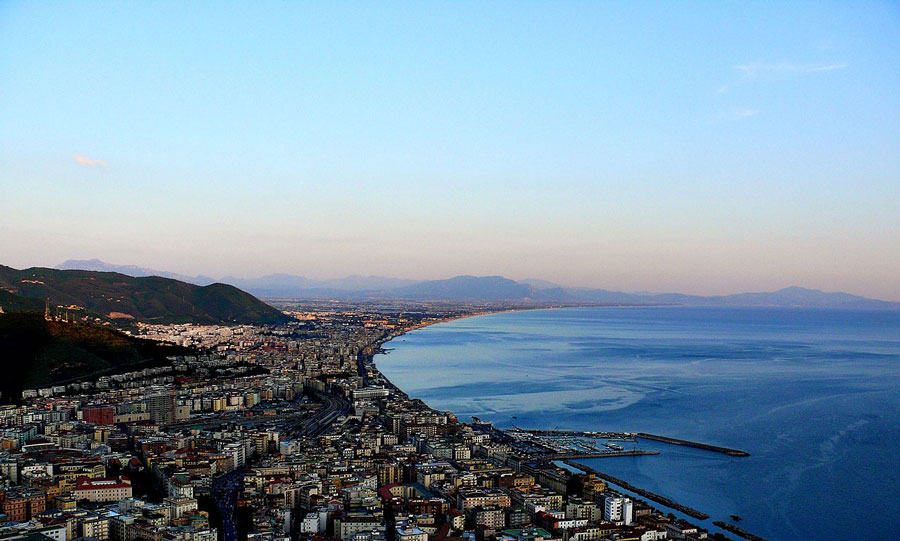Salerno
March 6, 2020
Categoria:
Salerno
 Nature
Nature
- Lungomare Trieste is the green promenade dearest to Salerno: designed in 1948, it was defined by the British in the 1950s as the most beautiful promenade in the Mediterranean. It spreads over 1.3 km and is home to several tree species including plane trees, palms and oleanders.
- Colle Bellara or Masso della Signora: a hill located in the eastern part of the city with vast wooded areas
- Monte San Liberatore, where there is an ancient 10th century hermitage, enlarged several times over time
- Parco del Mercatello
- Parco Pinocchio
- Parco dell’Irno
- Villa Ciro Bracciante
- Giardini Mariele Ventre
- Giardini della Carnale
- Parco Arbostella
- Parco del Galiziano
- Parco Buongiorno
- Parco del Seminario
 Religious Architectures
Religious Architectures
- Salerno Cathedral, built in the 11th century at the behest of Roberto il Guiscardo and Bishop Alfano I. Interesting, from an architectural and artistic point of view, is the bell tower in Arab-Norman style, 52 meters high and commissioned in the twelfth century.
- Sant’Andrea de Lavina and Santa Maria de Lama are from the Lombard era. The second was reopened to the public in 1996 and is built on a previous Roman construction. It preserves the only traces of Lombard painting still existing in the city.
- The Church of S. Pietro a Corte is very important from a historical and archaeological point of view, due to the numerous stratification, in the Lombard layout.
- The Church of Santissimo Crocifisso of the 8th century
- The Church of Monte dei Morti and the Church of San Filippo Neri , both of the sixteenth century and characterized by the octagonal plan, unusual in the city
- The Church of San Giorgio, from the beginning of the eighteenth century and called “the most beautiful baroque church” in the city
- Church of Annunziata
- Church of Sacro Cuore, built at the beginning of the 9th century
- Church of the Holy Family built in the Fratte district in 1971
- The Convent of San Nicola della Palma, hosting the EBRI (European Institute of Biomedical Research)
- The Convent of San Lorenzo, dating back to the 10th century, houses the headquarters of the Municipal Historical Archive
 Monuments
Monuments
- Castello di Arechi, built in the late Roman or Byzantine period, which became the cornerstone of the city’s triangular defense system
- Bastille, circular watchtower
- Carnale, cavalry tower built in 1569 on a promontory originally connected to the Bellara hill. The Carnale also served as a watchtower, together with the other watchtowers of the Amalfi and Cilento coast, against Saracen raids.
- The watchtowers, among which we remember: Torre Angellara, Torre dei Ladri, Torre di Guaiferio and the Torre del Cetrangolo
- Annunziatella fountain characterized by a loggia with a domed roof
- Fountain of Neptune, located in the courtyard of the Ruggi d’Aragona Palace, located in a semicircular niche in the Rococo style
- Fish fountain designed by Luigi Vanvitelli
- Tenna Fountain in Piazza Abate Confort
- Fontana del Tullio, built in 1790 along the road that connected Salerno to Naples, located in the municipal villa
- Medieval aqueduct, built by the Lombards in the 9th century. Consisting of two branches that join in via Arce and continue south towards the monastery, it rests on pointed arches, probably one of the first uses of this type of arch. A part of the aqueduct has been popularly called “Devil’s Bridge”
 Archeological sites
Archeological sites
- Etruscan-Samnite archaeological area of the Fratte district: a small and thriving commercial center founded around the 6th century BC. by groups of Etruscans from nearby Amina
- Heraion at the mouth of the Sele or temple of Hera Argiva is an ancient sanctuary of Magna Grecia dedicated to the goddess Era, located about 9 km from the city of Paestum
- Archaeological complex of San Pietro a Corte, a thermal system built around the 1st century AD, in the middle imperial age. The area of the frigidarium was later used in the early Christian era, around the fifth century as a cemetery with an adjoining ecclesia. When Arechi II moved the court of the principality of Benevento to Salerno, he built his palace and the Palatine chapel. The site of S. Pietro a Corte is therefore a very important testimony of Lombard history, as it is the only evidence of Lombard palatial architecture
- In the historic center, during stratified excavations or following fortuitous discoveries, Roman stratifications were found, below the medieval Lombard or Norman level. This is the case of the domus romana of Vicolo della Neve or the traces of a pagan temple, probably dedicated to Pomona, at the archiepiscopal palace.
 Museums
Museums
- Provincial Archaeological Museum housed in Palazzo Durazzo, also known as Castelnovo Reale, historical residence of Queen Margherita. The museum contains finds from the Samnite, Etruscan and Roman eras found in the province or in the city of Salerno itself, in particular in the archaeological area of Fratte. Among the most beautiful pieces there is a head of Apollo, attributed to Pasiteles
- Diocesan Museum , located in the former archiepiscopal seminary, which exhibits works ranging from the XII to the XVIII century. Particularly important is the section of sacred art of the Middle Ages among which the Salernitani ivories, among the major unit complexes of medieval ivories, and the exultet (illuminated manuscript) are worth mentioning. Among the paintings there are works by Francesco Solimena, Andrea Sabatini, Luca Giordano and Cesare da Sesto.
- Provincial art gallery , which collects works ranging from the Renaissance to Futurism
- Virtual museum of the Salerno medical school , located in the 11th century Church of San Gregorio, is a remarkable exhibition of ancient medical instruments and interactive reproductions of the famous medieval city codes, of its medical treatises preserved in libraries from all over the world and modern multimedia exhibitions of the history of medicine and the Salerno School
- Roberto Papi Museum , located in the historic Palazzo Galdieri, exhibits a collection of medical and surgical tools and instruments dating from the seventeenth and twentieth centuries
- Museum of the landing and Salerno Capitale is located in the premises of the Gallotta Institute in via Generale Clark
- “Alfonso Tafuri” Ceramics Museum
- Exhibition center and monumental complex of Santa Sofia is a former tenth century convent dedicated to Santa Sofia, which has become a multimedia space for exhibitions and events
 Events
Events
- September 21: is the Feast of San Matteo , patron of the city. On this occasion, the silver statue of the saint crosses the city center in a procession. The attraction of the festival is the traditional “rowing of S. Matteo” which takes place on the morning of the 21st in the body of water in front of the Trieste waterfront, and in which the six crews made up of the “paranze” who carry the Saints in the procession take part. On the occasion of the celebrations, band ensembles of national and international fame are hired and they generally perform in Piazza Amendola. For ancient custom, the party ends after the splendid midnight fireworks display, fired from a pontoon to the sea in front of the promenade. The classic final blow officially ends the celebrations in honor of the patron saint.
- Festival del Cinema di Salerno
- Shadow Line – Young Culture Festival : an event that has been held annually since 1995 and presents events related to contemporary creativity
- Crucifix Fair , which includes shows, historical re-enactments and is a showcase for local crafts and is considered one of the most important historical re-enactment events in all of Italy
- Luci d’artista is an event that has been taking place since 2006 in the period from the beginning of November to the end of January. Following the model of what was done in Turin, lights of particular scenographic effect and luminous works by local and non-local artists are installed in the main streets of the city and in the municipal villa.
- The Salerno Literature Festival is a cultural event born in 2013 which is held every year in the last week of June

